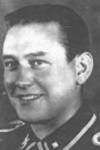Allegiance Nazi Germany Name Kurt Bolender Years of service 1930s–1945 Battles and wars World War II | Battles/wars World War II Service/branch Schutzstaffel Awards Iron Cross 2nd Class Unit SS-Totenkopfverbande | |
 | ||
Born May 21, 1912Duisburg, German Empire ( 1912-05-21 ) Rank SS-Oberscharfuhrer (Staff Sergeant) Commands held Operated gas chambers at Sobibor Camp III Died October 10, 1966, Hagen, Germany Similar Franz Reichleitner, Karl Frenzel, Odilo Globocnik | ||
Heinz Kurt Bolender (May 21, 1912 – October 10, 1966) was an low level SS commander during the Nazi era. In 1942 Bolender operated the gas chambers at Sobibór extermination camp, thereby directly perpetrating acts of genocide against Jews and Gypsies during the Nazi operation known as Operation Reinhard.
Contents
After the war, Bolender was recognized in 1961 while working under a false identity as a doorman at a nightclub in Germany, and subsequently accused in 1965 of personally murdering at least 360 Jewish inmates and assisting in the murder of 86,000 more at Sobibór. He committed suicide in prison two months prior to the end of the trial.
Biography
Bolender was born in 1912 in Duisburg and stayed in school until the age of 16 when he became a blacksmith apprentice. He joined the NSDAP in the 1930s.
In 1939 Bolender joined the SS-Totenkopfverbände ("Death's Head Unit"). He was attached to the Action T4 euthanasia program and worked at Hartheim, Hadamar, Brandenburg and Sonnenstein killing centers where physically and mentally disabled Germans were exterminated by gassing and lethal injection. Bolender was involved in the cremation process of disposing of victims, as well as "test" gassing procedures during the Action T4. During this period he worked with Franz Stangl and Christian Wirth. In 1941-1942 he was attached to an ambulance unit on the Eastern Front in Russia along with the other T-4 workers.
Sobibór extermination camp
On April 22, 1942, SS-Obersturmführer (First Lieutenant) Franz Stangl was appointed commandant of Sobibór. Stangl appointed SS-Oberscharführer (Staff Sergeant) Kurt Bolender as his deputy due to their prior work relationship and his extensive experience in the T-4 program. Bolender served as commander of Sobibór Camp III (gas chambers/crematoriums) from April until Autumn of 1942. He was one of the most feared men at the camp.
At Sobibór, Bolender actively participated in operating the gas chamber. SS-Scharführer Erich Fuchs, who served with Bolender, testified about him in 1966:
Part of Bolender's duties included supervision of the Jewish work details in Lager III. In his own words:
SS-Oberscharführer Erich Bauer, who also served with Bolender at Sobibór, testified about him in 1966:
Also, according to Bauer, Bolender forced female prisoners into entertaining himself and other SS personnel during orgies, prior to killing them.
In 1965, Ada Lichtman, a Sobibór survivor, described Bolender and his dog:
In the Autumn of 1942, Bolender became the commander of all the Ukrainian camp guards at Sobibór.
Moshe Bahir, a Sobibór survivor, wrote about Bolender:
In December 1942, Bolender's duties at Sobibór were temporarily put on hold when he was convicted by a (Nazi) German court of inciting a witness for perjury during divorce proceedings with his wife. For this, he was sentenced to a short prison term in the Kraków SS prison camp Danzig Matzkau. After serving the sentence, he returned to Operation Reinhard. However, on 14 October 1943, there had been a successful uprising and escape of prisoners at Sobibór, which caused Operation Reinhard to come to an end. Therefore, Bolender instead returned to the operation at the SS labor camp at Dorohucza and subsequently to Trieste in Italy. On 18 January 1945, Bolender was awarded the Iron Cross 2nd class. As the war came to a close, Bolender returned to Germany.
Arrest and trial
After World War II, Kurt Bolender assumed a fake identity, did not contact his family or his relatives, and after some time, had himself declared deceased. He was recognized in May 1961 working as a doorman at a nightclub in Germany and was immediately arrested. He was arrested under an assumed name Heinz Brenner which from German translates to "person who burns things" or "burner". It is probable that after the war he also went by the pseudonym Wilhelm Kurt Vahle while working as a doorman at the Er- und Siebar and the Hofbräuhaus in Hamburg. At his residence police found a whip with the silver initials "KB", the inscription that was created at the camp by Sobibór survivor Stanisław Szmajzner.
In 1965, Kurt Bolender, along with eleven former SS guards from Sobibór, was tried in Hagen, West Germany. At the trial Bolender initially claimed that he had never been in Sobibór, but instead fought against partisans around Lublin, Poland. However, he broke down under cross-examination and confessed to being present at Sobibór.
Prior to the completion of the trial, Kurt Bolender committed suicide by hanging himself in his prison cell. In his suicide note, he insisted that he was innocent.
